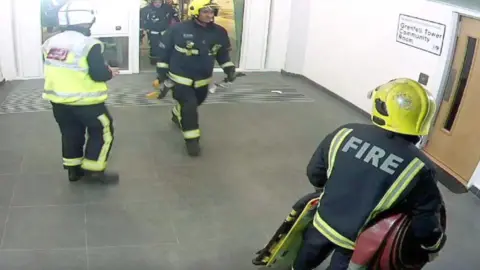Grenfell Tower inquiry: Firefighter 'untrained' in tower evacuation
The firefighter who led the initial response to the Grenfell fire said he was not trained to decide when to abandon the policy of "stay put" and evacuate a burning tower instead.
Michael Dowden told the inquiry he was "out of his comfort zone" when faced with the spreading blaze.
He also admitted failing to follow national guidance when carrying out safety checks on the tower in 2016.
Cladding, sprinklers, radio blackspots and escape routes were not checked.
At times during his appearance before the inquiry, Mr Dowden left long pauses - up to 25 seconds - before giving his answers.
Monday's hearing ended early as he felt unable to continue after more than six hours of questioning.
Mr Dowden, watch manager at North Kensington fire station, visited Grenfell Tower in February 2016 - 16 months before the fire that killed 72 people.
He was asked at the inquiry:
- Whether he was aware of guidance issued by the London Fire Brigade in July 2016 which stressed the "need to understand what products are being used in the facade system and their fire behaviour". Mr Dowden replied: "No, no I wasn't"
- Whether on his inspection, he assessed the evacuation procedures for the tower. He replied: "I cannot recall that I did, no"
- Whether he investigated if there were people in the block whose grasp of English potentially "obstructed" the evacuation advice in place. Mr Dowden said: "I cannot recall"
- Whether he checked the sprinkler system. Mr Dowden said: "No"
Mr Dowden said he did familiarise himself with the dry riser system - the means by which fire crews get water up a tall building. However, they should not be used in buildings above 50m - Grenfell is 67m.
Asked whether he had thought during his visit, "this building exceeds 50 metres, what's it doing with a dry riser?" Mr Dowden replied, "No, I didn't."

At the inquiry
 Grenfell Tower Inquiry
Grenfell Tower InquiryBy Tom Symonds, home affairs correspondent
This is not a court. Watch manager Michael Dowden is not accused of anything and stood today in his dress uniform to provide facts, not to defend himself.
But what he said raises deep questions about the degree to which the London Fire Brigade was prepared for the inferno on 14 June 2017.
It is expected (in government guidance) to specifically assess the risk of fires in tall buildings, fuelled by cladding, and to train its commanders to make the decisions needed to switch from a "stay-put" policy to "everyone out".
Mr Dowden's evidence is that not a lot of that has happened. Other firefighters will give evidence shortly, but he was in charge for the critical golden hour when perhaps the fire could have been stopped and the building evacuated. If anyone needed that training and prior planning, it was him.
His evidence is vital for an inquiry determined to learn the lessons of this tragedy. But lurking in the background is a police inquiry looking for evidence of corporate criminality, potentially breaches of health and safety by the fire service. His evidence will be vital to that process too.

Mr Dowden was also questioned at length about his training, particularly around high-rise flats and the brigade's adherence to a stay-put policy for the residents.
Most towers are designed so fires can be contained in the flats where they start, but this did not happen at Grenfell Tower, with the external cladding cited as the "primary cause" of the fire spreading.
One expert has said the fire service should have abandoned its advice to residents to stay in their flats much earlier than it did.
Victims' families have also been critical of the advice.
Counsel for the inquiry Richard Millett said according to policy, incident commanders "should understand" when an evacuation would be necessary and asked Mr Dowden what training he had for that situation.
After a 17-second pause, Mr Dowden said: "I can't remember any time when I'd actually been on a training course that would facilitate that."
He said it was "very difficult" to rehearse high-rise fire responses as "we don't have a high-rise facility to train on".
Mr Dowden added the advice to residents was "borne out of the way a building should behave in a fire".
Mr Dowden, who has been a firefighter for 14 years, said he had not realised the tower's exterior cladding could spread a fire.
He was also asked if he had looked at the cladding on his visit in February 2016.
"That's something I didn't look at," he said, but he added: "Knowing what I know now, that is certainly something I would look at."
'Difficult exercise'
Turning to the night of the fire, Mr Dowden was asked about what information he got from the fire brigade's mobile database en route to the tower block.
He said he could "only presume" the building information he was working off that night was a floor plan written in 2009 that did not include an extra three floors installed in the 23-floor building in a re-fit.
The information also said Grenfell had a "stay-put" policy.
The fire officer said in his written statement that the inferno quickly moved outside his "comfort zone" as an incident commander.
A short while later, the hearing took a break.
But when it resumed, Mr Millett said he had been told Mr Dowden was unable to continue answering questions on the day.
Inquiry chairman Sir Martin Moore-Bick said he had been "becoming increasingly concerned" that Mr Dowden, who insisted on standing throughout the hearing, was finding it a "difficult exercise" and said arrangements for his evidence should be considered before the night of the fire is discussed further.
